The AMD Llano Notebook Review: Competing in the Mobile Market
by Jarred Walton & Anand Lal Shimpi on June 14, 2011 12:01 AM ESTApplication Performance, Round One: PCMark 7
If the battery life was a pleasant change of pace, general application unfortunately remains a weak spot for AMD. Remember that Llano uses a tweaked K10.5 architecture for the CPU portion of the core, and while L2 cache per core is doubled relative to the previous generation quad-core Phenom parts, clock speeds and IPC (instructions per clock) still appear much lower than what Intel offers. I had hoped to see Turbo Core come into play here, which makes the comparison with Toshiba’s A660D a good starting point. That notebook has a Phenom II X4 P920 (quad-core 1.6GHz) with HD 5650M graphics, so the Llano A8-3500M has very similar specs.
Before we get to the graphs, let me make a quick note that not all laptops have been tested in all applications/games. Most of the systems have been shipped back to the manufacturer, so our newer benchmarks are going to have omissions (e.g. PCMark 7). In the gaming charts later in the review, we’ll have even more omissions, and many of the slower GPUs/IGPs will only be tested at our “low” settings.
With that out of the way, let’s start our application performance comparison with PCMark7, our only all-inclusive benchmark for laptops right now. We’ve run all of the benchmarks suites in the hopes of providing a better look at overall performance; however, outside of the “Computation” suite all of the tests have a storage element. That means any system with an SSD (like the quad-core SNB unit) will boast a massive advantage over the competition. The Computation suite also has an interesting footnote in that it supports Intel’s Quick Sync for video encoding, which again gives SNB systems a massive performance advantage. You can read more about the specific suites in PCMark 7 in their whitepaper. We’ll also have two results for Llano going forward: one for using the fGPU (6620G) and a second for using the dGPU (6630M).
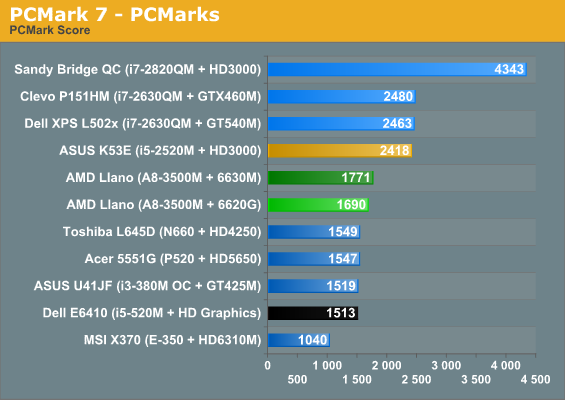
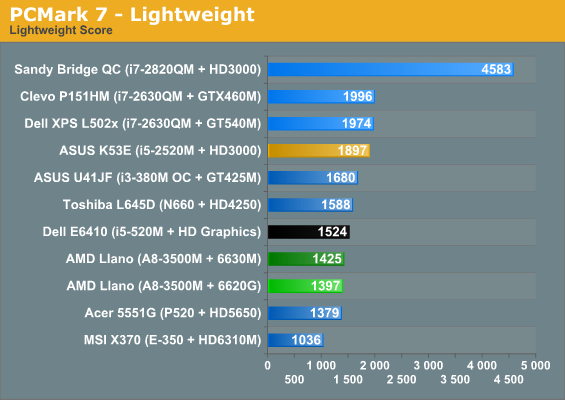
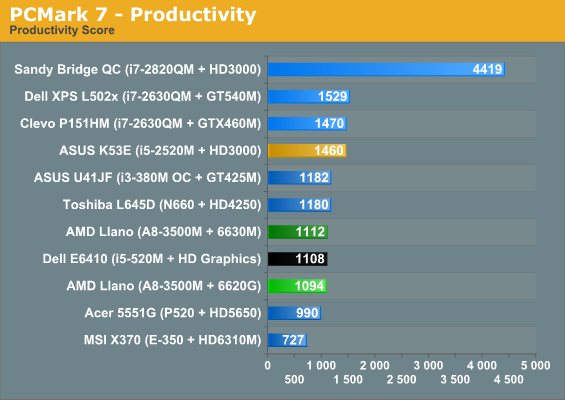
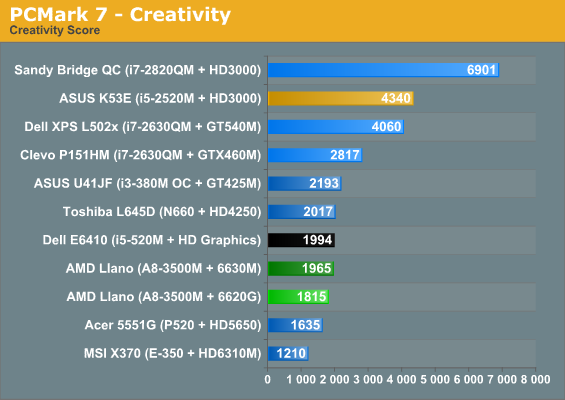
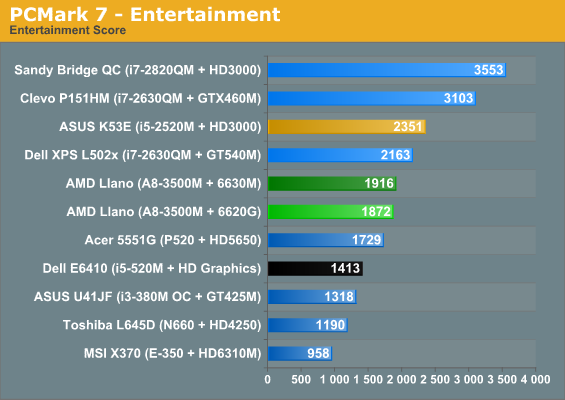

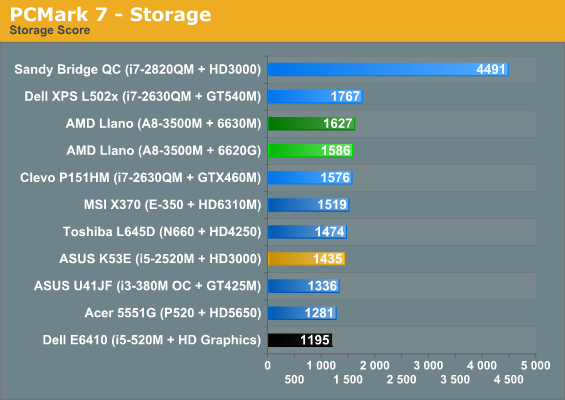
And here’s our first hint that Llano may not be the homerun so many were hoping to see from AMD. All of the SNB laptops are still a healthy step up from Llano in overall PCMarks—the K53E leads by 43%, and systems with quad-core SNB are faster still. Llano might appear to at least surpass the previous generation Arrandale i5-520M in Dell’s E6410, but the storage subsystem in that laptop is a particularly slow 160GB HDD and that skews the results. Then again, the overclocked Arrandale i3-380M in the ASUS U41JF falls short of Llano, so AMD is at the very least competitive with Arrandale.
Since we’re not on a level playing field as far as storage, we won’t comment too much more here, but I do have SSD-based testing complete for four of the notebooks, and once I’ve swapped in an SSD for Llano we’ll have a follow-up article. Let’s move on to application testing round two, where we’ll look at some tests where we eliminate the storage bottleneck.










177 Comments
View All Comments
duploxxx - Sunday, June 19, 2011 - link
talking about crap??? men you are good at that, as if you need a 2600K for some compiling and add a 6990 to an e-350.men you do know someting about computers :) your a joke
BushLin - Wednesday, June 22, 2011 - link
If you're going to accuse someone of talking crap (correctly or otherwise) it helps if you know the difference between you're and your when attempting to insult them.Broheim - Monday, June 27, 2011 - link
I use a fast CPU for compiling because I actually like being productive rather than just staring at the screen.my point about the 6990 was that a faster GPU != a better user experience for the vast majority of users, but logic seems to be lost on you.
Regenweald - Tuesday, June 14, 2011 - link
I'm currently playing the Witcher extended with a 2Ghz X2 ,a 4670 and 800 Mhz memory on a desktop with no complaints. In game settings medium and high. Are you saying that 2 more tweaked 32nm cores, 80 more shaders and ddr3 1600 or 1800 memory will not offer a good mobile gaming experience ? please.jollyjugg - Wednesday, June 15, 2011 - link
What kind of super computing application are you going to do in your laptop that you would need that "tremendous CPU power" that you are talking about. As somebody who has used both intel and amd machines for years I can tell you that for most user applications, you will hardly notice any difference in performance. The main complaint was that AMD machines were running hot particularly after intel cameup with power gating in nehalem in 2008. With this part you get a machine that runs way way cooler and almost 150- 200 bucks cheaper than comparable intel machines plus you get discrete quality graphics for free. Nobody can change cynics like you. Because you cant expect Intel to sell anything cheap you would want to AMD to sell things cheaper. Well if you want good things in life you should be prepared to pay. Dont write trash. Like gaming is not important for average user, tremendous computing power and 3 GHz CPU speed is also not important for the average PC user. But multimedia and movie rendering etc is. So go Llano!!!Seikent - Tuesday, June 14, 2011 - link
This platform offer some good things, but if the prices aren't low it won't go well. Now it's quite easy to find a sandy bridge notebook with discrete gpu for a few more dollars.If ACF does achieve to work like CF in the future, it would be great!
SteelCity1981 - Tuesday, June 14, 2011 - link
Finally we have an intergrated graphics solution that's worth really talking about.aegisofrime - Tuesday, June 14, 2011 - link
Judging by the performance, this part won't be priced very high. And that's a worry, considering that it packs 1.45 billion transistors. In comparison, Sandy Bridge is 995 million transistors, and sells for more money. Profit margins are gonna be tight on this one.JarredWalton - Tuesday, June 14, 2011 - link
AMD has a slide that points out that compared to their previous generation, they're packing a 66 mm2 Northbridge, 200 mm2 CPU, and 1080 mm2 dGPU into a 228 mm2 package. They've made money this past quarter, so this should do better than Athlon/Phenom II.JarredWalton - Tuesday, June 14, 2011 - link
Note: that's supposed to be 108 mm2 GPU, not 1080. Whoops.